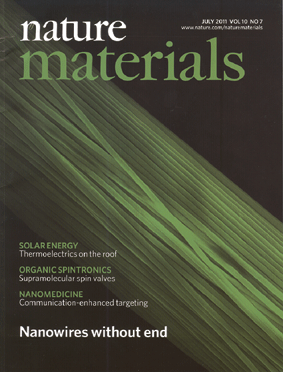Nanostructures without End
Bilkent Researchers Invent a New Nanofabrication Method
 An experimental scientist, working on silicon nanoparticles to make printable electronics, once half-jokingly summarized her lab work as "baking and cooking." She wasn't far from the truth. For example, compare this recipe for "pişmaniye," a traditional candy made of thin fibers, to another process, that of making very thin wires, reported by Asst. Prof. Mehmet Bayındır and his team in Nature Materials' July issue as the cover story.
An experimental scientist, working on silicon nanoparticles to make printable electronics, once half-jokingly summarized her lab work as "baking and cooking." She wasn't far from the truth. For example, compare this recipe for "pişmaniye," a traditional candy made of thin fibers, to another process, that of making very thin wires, reported by Asst. Prof. Mehmet Bayındır and his team in Nature Materials' July issue as the cover story.
First, the halvah fiber making: an annular dough made from sugar and oil is gradually elongated by an axial reverse roll followed by folding into a double ring. When this process is iteratively repeated a score of times, using flour to make sure strands of the dough fibers do not recombine, the result is a delicate candy of very light, tenuous fibers.
If you can believe it, nearly the same fabrication process of iterative drawing is used to obtain semiconducting nanowires, nanotubes and core-shell nanowires. The nanowires and nanotubes obtained by this interestingly similar method might, it seems, solve a fundamental problem in nanowire research, that is, the integrability and mass production of tiny ordered structures. It's pretty amazing how much you can do with simple baking and cooking!
Nanowires, manmade materials only a few nanometers (one-billionth of a meter) in diameter with unusually attractive properties that make them the focus of nanotechnology and materials research today, are rarely a fraction of a millimeter long. They are especially interesting due to their one-dimensional structure, because of which they can be used as interconnects and, when crossed over, as switches or pixels. Miniaturization is widely sought after in technology: it means there is much less power needed for operation, a much quicker response time and high packing density. Here's the catch, though. How do you collect and manipulate these semiconducting nanowires and then connect them to our world? Nanowires' promise might be appealingly big but their size is way too small.
 The new fabrication technique, reported in Nature Materials by the Bayındır research group at UNAM-National Nanotechnology Research Center, is essentially a size reduction technique. Controlled thermal size reduction is repeated iteratively until a macroscopic rod is scaled down to nano size radially while elongated axially. In this way, a variety of semiconducting, piezoelectric and polymer nanowires and tubes can be produced. Millions of ordered, indefinitely long nanowires, nanotubes, and one-dimensional core-shell structures are obtained in a protective polymer. The nanostructures are aligned and ready to be connected to large scale systems through the facets of the fiber in order to use their nano features, such as photoconductivity or phase change properties. But the use of the structures is not confined to electronics. These nanowires can also be used in large-area photonics applications as non-pigment colors, as well as in next-generation solar cells to improve their efficiency as effective light concentrators. It seems that the process of fiber drawing has just been reinvented in the age of nanotechnology.
The new fabrication technique, reported in Nature Materials by the Bayındır research group at UNAM-National Nanotechnology Research Center, is essentially a size reduction technique. Controlled thermal size reduction is repeated iteratively until a macroscopic rod is scaled down to nano size radially while elongated axially. In this way, a variety of semiconducting, piezoelectric and polymer nanowires and tubes can be produced. Millions of ordered, indefinitely long nanowires, nanotubes, and one-dimensional core-shell structures are obtained in a protective polymer. The nanostructures are aligned and ready to be connected to large scale systems through the facets of the fiber in order to use their nano features, such as photoconductivity or phase change properties. But the use of the structures is not confined to electronics. These nanowires can also be used in large-area photonics applications as non-pigment colors, as well as in next-generation solar cells to improve their efficiency as effective light concentrators. It seems that the process of fiber drawing has just been reinvented in the age of nanotechnology.
The most interesting aspect of the nanostructures Asst. Prof. Bayındır's team has produced at UNAM is that these are the first large-scale, mass-producible, easily manageable nanostructures conveniently embedded in a polymer fiber. The wires can be produced to any radial size, from 1 micrometer to 10 nanometers, and cut indefinitely long in the axial direction. The electrical connection to the wires is as simple as cleaning both facets of the polymer jacket and contacting using a metallic paste. Integrability, high throughput and polymer encapsulation features are likely to spawn fresh applications in the field. The authors list a number of applications, ranging from nanowire electronics, semiconductor nanophotonics and solar concentrators to lab-in-a-fiber applications. If the unusual structures prove to be good for some of these applications, the fruit of the endless hours of toil that went into designing and producing the structures for the past three years might be as sweet as their candy cousins.